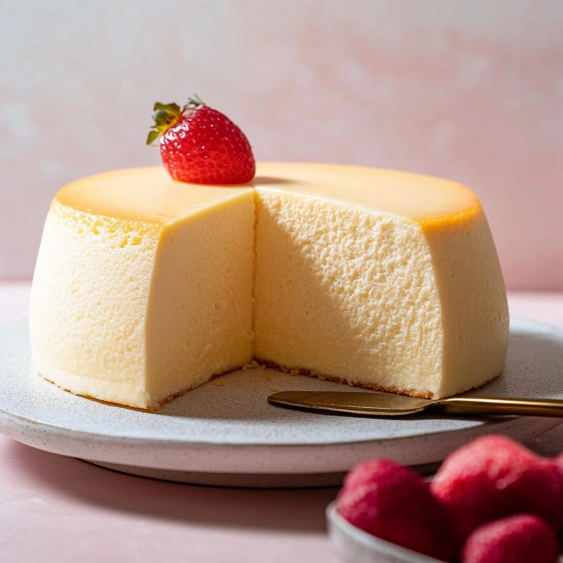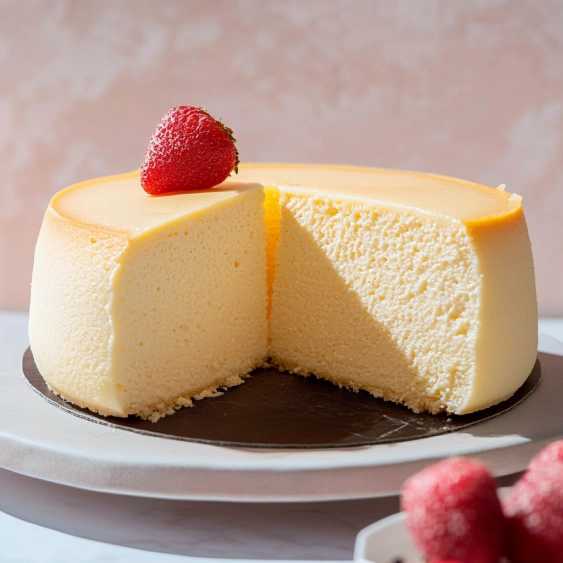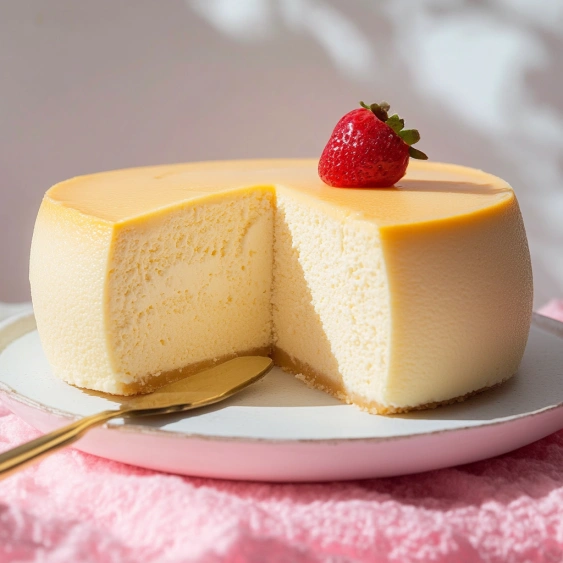 Pin it
Pin it
This ethereal Jiggly Japanese Cheesecake brings cloud-like texture and delicate sweetness to your table. Unlike dense New York-style versions, this soufflé-inspired cake dances with a mesmerizing wobble when fresh from the oven, creating an unforgettable dessert experience that's equally impressive to serve and delightful to eat.
I discovered this recipe during a deep dive into Japanese baking techniques, and it's become my signature dinner party finale. The first time I successfully achieved that perfect wobble, my entire family gathered around the kitchen counter just to watch it jiggle before demolishing it in minutes.
Ingredients
- Cream cheese: Full-fat Philadelphia creates the signature tangy flavor base while providing structure
- Unsalted butter: Adds richness and ensures a velvety mouthfeel
- Whole milk: Helps create the perfect batter consistency for optimal rise
- All-purpose flour: Provides structure while keeping the texture delicate; look for low-protein content varieties
- Corn starch: Crucial for that signature melt-in-your-mouth texture
- Salt: Enhances all flavors and balances the sweetness
- Eggs: Separated into yolks and whites; the whites will create the magical soufflé effect
- Granulated sugar: Superfine; dissolves better in the meringue for optimal volume
Step-by-Step Instructions
- Prepare Your Equipment:
- Begin by lining a 20 cm round cake pan with parchment paper, being meticulous about covering the bottom and sides completely. Preheat your oven to 150°C with a water bath already inside. The water should reach halfway up your cake pan's sides when placed inside. This gentle, moist heat environment is absolutely crucial for achieving that signature jiggle without cracks.
- Create The Cheese Base:
- Place cream cheese, butter, and milk in a saucepan over the lowest possible heat. Stir continuously until completely smooth with no lumps whatsoever. This process should be done slowly to avoid overheating, which can cause the mixture to separate. The finished base should look glossy and have the consistency of thick custard.
- Incorporate Dry Ingredients:
- Sift the cornstarch, salt, and flour directly over your cheese mixture to prevent any lumps. Fold these in gently but thoroughly until your batter becomes smooth and silky. This step builds the structure that will support the airy meringue while maintaining that characteristic jiggly texture.
- Add Egg Yolks:
- Incorporate the egg yolks one at a time, mixing thoroughly after each addition until fully absorbed. The mixture will gradually become a richer yellow color and take on a custard-like consistency. This patient, gradual addition ensures proper emulsification for the perfect texture.
- Whip The Meringue:
- Using absolutely clean and dry equipment, whip the egg whites starting on low speed. Gradually add sugar one tablespoon at a time while increasing mixer speed. Continue until the meringue forms soft peaks that gently curve when the beater is lifted. The meringue should be glossy but not stiff, retaining enough flexibility to fold properly.
- Combine And Bake:
- Fold the meringue into the cheese mixture using a rubber spatula with deliberate, gentle motions. Cut through the center, sweep along the bottom, and fold over repeatedly, rotating the bowl slightly between folds. Pour into your prepared pan and place in the water bath. Bake following the three-stage process described in the instructions, watching carefully for that golden brown top and slight jiggle in the center.
 Pin it
Pin it
My fascination with this cake comes from the magical transformation of simple ingredients into something so technically impressive. I particularly love how the cornstarch works silently behind the scenes to create that unmistakable melt-in-your-mouth texture that distinguishes Japanese cheesecake from all other varieties.
Mastering The Meringue
The meringue is the heart and soul of this cheesecake's unique texture. For best results, bring your eggs to room temperature before separating, as warm egg whites whip to greater volume. Ensure your mixing bowl is completely free of any fat residue by wiping with lemon juice or vinegar before beginning. When whipping, look for soft peaks that hold their shape but gently curl at the tips. Overbeaten meringue becomes dry and difficult to incorporate, resulting in a denser cake with less jiggle.
The Science Of The Jiggle
The signature wobble comes from the delicate balance between structure and airiness. The flour provides just enough framework to hold the cake together, while the whipped egg whites create thousands of tiny air pockets throughout. During baking, these air pockets expand, giving the cake its soufflé-like rise. The water bath maintains a consistent, gentle heat that allows the proteins to set slowly without overcoagulating, resulting in that perfect tender texture that jiggles when moved.
 Pin it
Pin it
Serving And Storage
Japanese cheesecake experiences three distinct phases of deliciousness. Serve it warm from the oven for maximum jiggle and a custardy interior. At room temperature, it develops a more cake-like texture while retaining its lightness. Refrigerated, it becomes more dense and creamy, similar to traditional cheesecake but still distinctively lighter. For the full experience, I recommend trying it at all three stages. To store, place in an airtight container in the refrigerator for up to three days, though the texture is truly at its peak within the first 24 hours.
Frequently Asked Questions
- → Why is my Japanese cheesecake cracking on top?
Cracks usually occur due to rapid temperature changes or overbaking. Ensure you're using a proper water bath that reaches halfway up the cake pan, bake at the recommended temperature, and follow the three-stage baking process. Opening the oven door slightly during the second stage helps release steam gradually to prevent surface tension.
- → How do I know when my Japanese cheesecake is done?
The cheesecake is done when it has a golden-brown top, feels soft and springy to touch, and has a slight jiggle in the center. It should not be wet or liquid in the middle, but maintain some movement. Using a digital thermometer helps ensure your oven temperature is accurate.
- → Can I make Japanese cheesecake without a stand mixer?
Yes, you can use a hand mixer instead of a stand mixer for beating the egg whites into meringue. The key is achieving soft peaks by gradually adding sugar while increasing the speed. Just ensure your bowl and beaters are completely clean and free from any fat residue for successful meringue.
- → Why does my Japanese cheesecake deflate after baking?
Some deflation is normal as the cheesecake cools, but excessive sinking may indicate underbaking or improper meringue. Make sure your egg whites reach soft peaks before folding into the batter, and be gentle when incorporating to maintain air bubbles. Proper baking time and temperature are also crucial.
- → How long does Japanese cheesecake stay jiggly?
The signature jiggle is most pronounced when the cheesecake is fresh and warm. While the dessert remains delicious for 2-3 days in the refrigerator, the airy, jiggly texture is best enjoyed immediately after baking when the structure is at its most delicate.
- → Can I use low-fat cream cheese for Japanese cheesecake?
Full-fat cream cheese is strongly recommended for the best texture and flavor. Low-fat varieties contain more moisture and less fat, which can negatively affect the cake's structure and richness. Philadelphia brand cream cheese is specifically mentioned in the recipe for its consistent quality.
